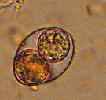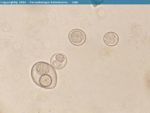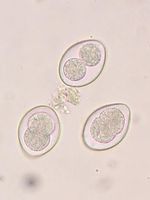Difference between revisions of "Coccidiosis - Cat & Dog"
| (5 intermediate revisions by the same user not shown) | |||
| Line 1: | Line 1: | ||
| − | + | [[Image:Isospora felis sporulated.jpg|thumb|left|150px|<i>Isospora felis</i> sporulated - Courtesy of the Laboratory of Parasitology, University of Pennsylvania School of Veterinary Medicine]][[Image:Isospora felis.jpg|thumb|right|150px|<i>Isospora felis</i> - Joaquim Castellà Veterinary Parasitology Universitat Autònoma de Barcelona]] [[Image:Isospora felis unsporulated.jpg|thumb|left|150px|<i>Isospora felis</i> unsporulated - Courtesy of the Laboratory of Parasitology, University of Pennsylvania School of Veterinary Medicine]][[Image:Coccidia logo.jpg|thumb|right|150px|<i>Coccidia in Cat Faeces</i> <br /> Joel Mills, WikiMedia Commons]] | |
| − | |||
| − | |||
| − | + | == Introduction<br> == | |
| − | + | Coccidiosis in cats is much rarer than the common disease presentation in ruminants and poultry. Transmission of coccidia is via the faeco- oral route; ingestion of the oocysts. | |
| − | |||
| − | |||
| − | |||
| − | |||
| − | |||
| − | |||
| − | ==Clinical Signs == | + | There are two Isospora species found in the cat. Neither are of clinical significance. Often the cat must be immunosuppressed or in very poor condition in order for the disease to occur as small numbers of oocysts are not pathogenic. Even if the faecal oocyst count is high, other causes of diarrhoea should be investigated. Both species of Isospora have little pathogenicity. |
| + | |||
| + | == <br>Clinical Signs == | ||
Diarrhoea and weight loss. There may be anorexia and fever in severe cases. | Diarrhoea and weight loss. There may be anorexia and fever in severe cases. | ||
| − | == | + | == <br>Diagnosis == |
| − | |||
| − | |||
| − | |||
| − | |||
| − | |||
| − | |||
| − | + | Presence of a very high number of oocysts in the faeces, plus previous exclusion of other causes of diarrhoea. History of overcrowding or unhygienic condtions may also be indicative. | |
| − | + | Oocysts in faeces have to be distinguised from those of Toxoplasma (smaller) and Sarcocytis (sporulated or naked sporocyts in faeces).<br> | |
| − | == | + | == <br>Treatment and Control == |
| − | + | Sulfonamthoxine or Trimethoprin are the treatment of choice in cats.<br> | |
| − | + | Investigation should be undertaken into living conditions of the cat, or pre-existing medical conditions that may make the animal susceptable. | |
| − | + | == <br>References == | |
| + | Fox, M and Jacobs, D. (2007) Parasitology Study Guide Part 1: Ectoparasites Royal Veterinary College<br>Hall, E.J, Simpson, J.W. and Williams, D.A. (2005) BSAVA Manual of Canine and Feline Gastroenterology (2nd Edition) BSAVA<br>Tilley, L.P. and Smith, F.W.K.(2004)The 5-minute Veterinary Consult (Third edition) Lippincott, Williams & Wilkins. | ||
| − | + | <br> | |
| − | + | [[Category:To_Do_-_Review]] | |
| − | [[Category: | ||
| − | |||
Revision as of 17:59, 10 March 2011
Introduction
Coccidiosis in cats is much rarer than the common disease presentation in ruminants and poultry. Transmission of coccidia is via the faeco- oral route; ingestion of the oocysts.
There are two Isospora species found in the cat. Neither are of clinical significance. Often the cat must be immunosuppressed or in very poor condition in order for the disease to occur as small numbers of oocysts are not pathogenic. Even if the faecal oocyst count is high, other causes of diarrhoea should be investigated. Both species of Isospora have little pathogenicity.
Clinical Signs
Diarrhoea and weight loss. There may be anorexia and fever in severe cases.
Diagnosis
Presence of a very high number of oocysts in the faeces, plus previous exclusion of other causes of diarrhoea. History of overcrowding or unhygienic condtions may also be indicative.
Oocysts in faeces have to be distinguised from those of Toxoplasma (smaller) and Sarcocytis (sporulated or naked sporocyts in faeces).
Treatment and Control
Sulfonamthoxine or Trimethoprin are the treatment of choice in cats.
Investigation should be undertaken into living conditions of the cat, or pre-existing medical conditions that may make the animal susceptable.
References
Fox, M and Jacobs, D. (2007) Parasitology Study Guide Part 1: Ectoparasites Royal Veterinary College
Hall, E.J, Simpson, J.W. and Williams, D.A. (2005) BSAVA Manual of Canine and Feline Gastroenterology (2nd Edition) BSAVA
Tilley, L.P. and Smith, F.W.K.(2004)The 5-minute Veterinary Consult (Third edition) Lippincott, Williams & Wilkins.



